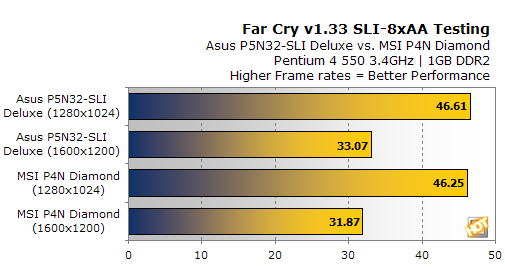Asus P5N32-SLI Deluxe nForce4 SLI X16 Intel Edition
|
Using the Coolbits tweak, the new SLI anti-aliasing rendering modes are available from within the advanced global driver options. After selecting "SLI antialiasing" from within the "SLI Rendering Mode" drop-down menu, two new AA modes are made available, SLI 8X and SLI 16X. We should note that these two modes replace the traditional AA options available within NVIDIA's Forceware drivers when enabled. Essentially, each GPU renders a frame and applies the appropriate filtering, then the two frames are blended, and finally the blended frame is sent out to the display. In the SLI8X AA mode, NVIDIA's 4X multi-sample AA is applied; in SLI16X AA mode, 8xS (4X multi-sample / 2X super-sample) AA is applied.


The screens may look better, but the performance hit using SLI-AA is enormous. We doubt many readers would expect to see framerates of 20-30fps in a typical SLI review. More importantly perhaps, is that we're not seeing any differences between the two boards. While we knew that SLI-AA would heavily tax systems when using the newer engines, we had hoped that the extra bandwidth afforded by the SLI-X16 chipset would have helped out here. Unfortunately, regardless of whether 16 or 32 PCI-e lanes were available, the framerates were almost exactly the same.






